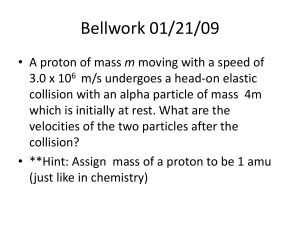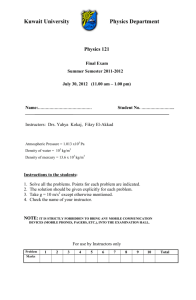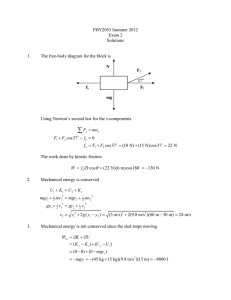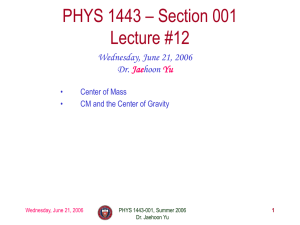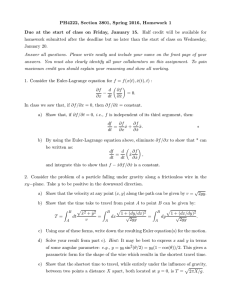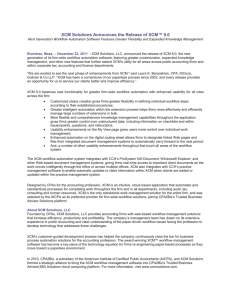r m
advertisement
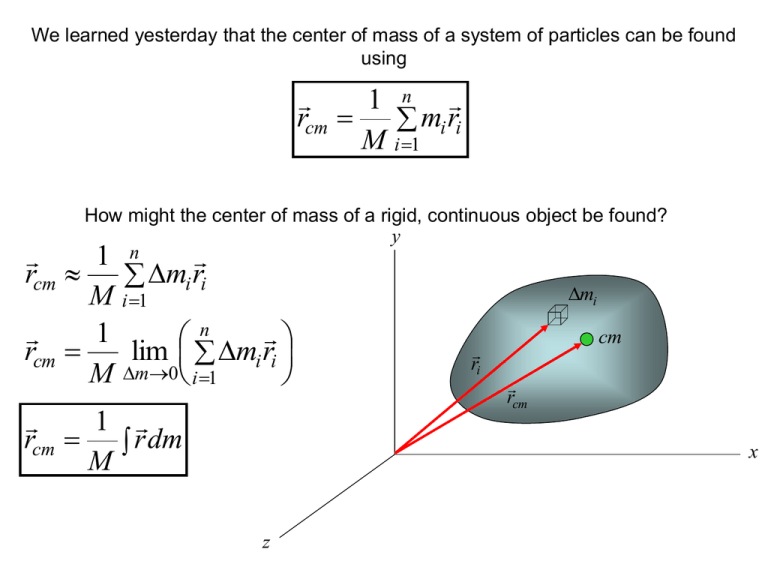
We learned yesterday that the center of mass of a system of particles can be found using 1 n rcm mi ri M i 1 rcm How might the center of mass of a rigid, continuous object be found? y 1 n mi ri M i 1 n 1 rcm lim mi ri M m0 i 1 1 rcm r dm M mi ri cm rcm x z Example 1 Show that the center of mass of a uniform thin rod of mass M and length L lies midway between its ends. y L dm Think of the thin rod as 1-dimensional x x dx 1 xcm xdm M Linear Density - Mass per unit length 1 L xcm 0 xdx M L xcm 0 xdx M xcm 1 2 L x M 2 0 M L dm dx dm dx Example 1 Show that the center of mass of a uniform thin rod of mass M and length L lies midway between its ends. y L dm Think of the thin rod as 1-dimensional x x dx 1 2 xcm x M 2 0 L Linear Density - Mass per unit length 1 2 1 2 xcm L 0 M 2 2 L2 xcm 2M M L2 xcm L 2M L xcm 2 M L dm dx dm dx Consider a system of particles. 1 n xcm mi xi M i 1 Mxcm m1x1 m2 x2 mn xn d d Mxcm m1x1 m2 x2 mn xn dt dt d d d d M xcm m1 x1 m2 x2 mn xn dt dt dt dt Mvcm m1v1 m2v2 mnvn Mvcm m1v1 m2v2 mnvn d d Mvcm m1v1 m2v2 mnvn dt dt d d d d M vcm m1 v1 m2 v2 mn vn dt dt dt dt Macm m1a1 m2a2 mnan But Newton’s Second Law says F ma Macm F1 F2 Fn Macm F For this system of particles there could be two types of forces. 1. Forces between the particles. 2. External forces from outside the system. However, by Newton’s Third Law, any force between two particles would always have an equal and opposite pair and would therefore sum to 0! F external Macm Newton’s Second Law for a system of particles Where M total mass of the system The total mass must remain constant, known as a closed system Example 1 A 50. kg person stands on the edge of a 3.0 m long cart of mass 40. kg which is on a frictionless floor as in the diagram below. If the person walks forward 1.2 m with respect to the floor, how far does the cart move? 50. kg 40. kg 3.0 m System = Cart, Person, Earth This is a closed, isolated system. F external Macm acm 0 Since the center of mass was initially at rest, it stays at rest! Example 1 A 50. kg person stands on the edge of a 3.0 m long cart of mass 40. kg which is on a frictionless floor as in the diagram below. If the person walks forward 1.2 m with respect to the floor, how far does the cart move? 50. kg 40. kg 3.0 m xi cm x f cm mc xci m p x pi mc xcf m p x pf M M mc xci mc xcf m p x pf Example 1 A 50. kg person stands on the edge of a 3.0 m long cart of mass 40. kg which is on a frictionless floor as in the diagram below. If the person walks forward 1.2 m with respect to the floor, howThat far does the cart move? Whew! was close! 50. kg 40. kg 3.0 m xcf mc xci m p x pf mc 40. kg 1.5 m 50. kg 1.2 m xcf 40. kg xcf 0 m x f xi x 1.5 m
